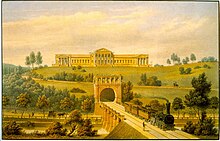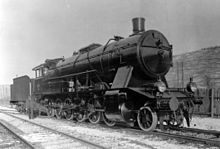Royal Württemberg State Railways

The Royal Württemberg State Railways (KWSt.E.) were the state railways of the Kingdom of Württemberg (since 1918 a free state of Württemberg ) between 1843 and 1920.
prehistory
As in many other states of the German Confederation , there were also considerations in the Kingdom of Württemberg from around 1825 to improve the state's traffic development. Private interest groups were formed, and from 1834 the state also dealt with this question and commissioned expert reports that were supposed to identify suitable solutions. Applications for concessions to build private railways (e.g. from the Württembergische Eisenbahngesellschaft founded in 1836 ) were initially rejected. The main lines were intended as state railways . The government and the king wanted to protect the interests of the state with regard to the seemingly lucrative transit traffic . In any case, intergovernmental negotiations were necessary to guide the lines to the neighboring states.
The construction of the route was legally stipulated by the Railway Act of April 18, 1843, making this day the date of birth of KWSt.E. has been. The law specifically stipulated that the construction of branch lines should also be possible by private companies. This law was at the same time the impetus for the establishment of the Esslingen machine factory , which significantly shaped railway vehicles and railway technology in Württemberg.
Overview of the development of the state railway lines
Trunk lines
In the Kingdom of Württemberg , the rail network initially developed with the Zentralbahn from Stuttgart along the Neckar , on the one hand via the Eastern Railway to Ulm and further via the Southern Railway to Friedrichshafen on Lake Constance , and on the other via the Western Railway to Bruchsal in Baden . The northern railway branched off from Bietigheim to Heilbronn .
| date | Beginning of section | End of section |
|---|---|---|
| October 22, 1845 | Cannstatt | Untertürkheim |
| November 7, 1845 | Untertürkheim | Obertürkheim |
| November 20, 1845 | Obertürkheim | Esslingen |
| October 15, 1846 | Cannstatt | Ludwigsburg |
| December 14, 1846 | Esslingen | Plochingen |
| October 11, 1847 | Plochingen | Cuties |
| October 11, 1847 | Ludwigsburg | Bietigheim |
| November 8, 1847 | Ravensburg | Friedrichshafen |
| July 25, 1848 | Bietigheim | Heilbronn |
| May 26, 1849 | Biberach | Ravensburg |
| June 14, 1849 | Cuties | Geislingen |
| June 1, 1850 | Biberach | Ulm |
| June 29, 1850 | Geislingen | Ulm |
| October 1, 1853 | Bietigheim | Boards |
| June 1, 1854 | Ulm | New Ulm |
Additions to the trunk lines
After a break of several years, construction began on the Upper Neckar Railway , which started in Plochingen in 1859 in Reutlingen , in 1861 via Tübingen to the bishopric of Rottenburg am Neckar, and in 1864/66, first to Eyach and then to the later Horb am Neckar node .
In eastern Württemberg, the Remsbahn was built from Cannstatt in 1861 via Schorndorf - Aalen to Wasseralfingen and in 1863 in Nördlingen the connection to the Bavarian rail network was established.
The cooker train ran through 1862 from Heilbronn the Hohenlohe plain to Schwäbisch Hall and from 1867 to Crailsheim , where in 1866 the traits of the Upper Jagst Railway arrived from Aalen and 1869, the Tauber Valley Railway after Mergentheim joined.
The Brenzbahn , which opened to Heidenheim an der Brenz in 1864 , but did not reach its destination until 1875/76, was supposed to provide a cross connection through the Ostalb from Aalen to Ulm . The spa town of Wildbad in the Black Forest was connected to the Pforzheim junction in Baden with the Enz Valley Railway in 1868 .
From Heilbronn the Lower Neckar Railway was extended to Jagstfeld in 1866 and from here three years later the Lower Jagst Valley Railway was extended to Osterburken ; In both stations, further connections to the Baden State Railway were established .
The Upper Neckar Railway reached Rottweil from Horb in 1867/68 and from there in 1869 the Baden town of Villingen in the Black Forest. In the same year the first trains of the Upper Danube Railway ran from Rottweil to Tuttlingen , from where in 1870 the connection to Immendingen on the Baden Black Forest Railway was established.

From Ulm, the Ulm – Sigmaringen railway was first built in 1868 to Blaubeuren before reaching Ehingen (Danube) in 1869 , Scheer in 1870 and finally Sigmaringen in 1873 . It took another six years for the Zollernalbbahn to connect Tübingen, which had already reached Hechingen in 1869 and Balingen in 1874 .
The Black Forest Railway branched off from Zuffenhausen to Weil der Stadt in 1868/69 and reached the town of Calw and on to Nagold in 1872 ; In 1874 the Nagold Railway ran continuously from Pforzheim via Calw-Nagold to Horb.
In Herbertingen in 1869 the Allgäu Railway branched off via Saulgau– Aulendorf to Waldsee . There it went on to Kißlegg in 1870 and to Leutkirch im Allgäu in 1872 ; Isny became a train station in 1874 .
The state railway then consolidated its network by building the following routes:
- 1876–1880 Murrtalbahn Waiblingen – Backnang – Schwäbisch Hall-Hessental and the Backnang – Bietigheim / Ludwigsburg junction
- 1878–1880 Kraichgaubahn Heilbronn – Eppingen
- 1879–1892 Gäubahn (Stuttgart – Singen) , Gäubahn (Eutingen – Freudenstadt) / Kinzigtalbahn Stuttgart – Herrenberg – Freudenstadt – Schiltach – Schramberg
- 1886–1889 Leutkirch – Memmingen railway line
- 1892–1893 Echazbahn Reutlingen – Lichtenstein – Münsingen
workshops
While since 1844 construction and repairs to the locomotives, wagons and other operating machines have largely been carried out at the Eßlingen machine works, privately established by the state railways , only the workshops set up at the first Heilbronn station were initially available for car repairs . That is why a Centrale car workshop was established in Cannstatt in 1869 , which became the nucleus of the repair shop .
vehicles
In terms of rail technology, KWSt.E. until about 1865 - like most German states - were not guided by the English, but by the American model. For the vehicles - both for locomotives and for wagons - this meant, for example, the use of open-plan cars and the use of bogies . This progressive path was temporarily abandoned due to strong influences mainly from Prussia . The color of the vehicles changed several times.
From 1885 to 1896, chief engineer Adolf Klose was responsible for the procurement and modification of locomotives . Under his leadership, composite locomotives and rack-and-pinion locomotives were procured for the first time. He also designed an engine to improve the cornering behavior of locomotives.
Eugen Kittel followed him . He introduced superheated steam in Württemberg. Under his leadership, among other things , the Kittel type steam railcars, the Württembergische C express locomotives and the Württembergische K freight locomotives were put into service. Gasoline and accumulator railcars were also tested.
A compilation and listing of the locomotives used by the Württemberg state railways can be found on the page List of Württemberg locomotives and railcars .
In 1913 the statistics showed the following figures.
- Route length (including private railways): 2,256 km
- Stations: 639
- Locomotives: 855
- Railcar: 17
- Passenger cars: 2,394
- Mail and baggage car: 760
- Freight cars (including railway company cars): 14,565
The steamship Friedrichshafen , built in 1909 and destroyed in 1944, was one of the state-owned railways' Bodensee steamers . After renovation in the period 1984 to 1990, the steamship Hohentwiel from 1913 is again in (charter) service on Lake Constance.
After the First World War , the Imperial Constitution of 1919 ended the independence of the Württemberg railway system. By means of a state treaty between the German Reich and the federal states, the Württemberg State Railways (the addition Royal became obsolete with the abdication of King Wilhelm II on November 30, 1918) became the property of the Reich on April 1, 1920 and formed together with the former state railways of Bavaria , Prussia , Saxony , Baden , Mecklenburg and Oldenburg form the basis of the Reichsbahn founded on April 1, 1920 .
See also
literature
- Bernd Beck: Swabian Railway. Pictures from the Royal Württemberg State Railway . Metz, Tübingen 1989, ISBN 3-921580-78-1 .
- Oscar Fraas : Württemberg's railways with country and people on the railroad . Swiss beard, Stuttgart 1880.
- Oskar Jakob: The K. Württemberg State Railways in a historical-statistical representation. a contribution to the history of the railway industry . H. Laupp, Tübingen 1895.
- Eberhard Kitter: The railway station building in the Kingdom of Württemberg before 1854 . Stuttgart 1973 (dissertation).
- Wolfgang Klee: Railway Journal Württemberg Report . tape 1 , no. V / 96 . Merker, Fürstenfeldbruck 1996, ISBN 3-922404-96-0 .
- Hans Kobschätzky: The Royal Württemberg State Railways. Your story, locomotives and wagons in words and pictures . Kosmos, Stuttgart 1982, ISBN 3-440-04815-2 .
- Georg von Morlok : The Royal Württemberg State Railways: Review of their construction during the years 1835–1889, taking into account their historical, technical and financial moments and results . Deutsche Verlags-Anstalt, Stuttgart 1890 (reprint: Siedentop, Heidenheim 1986, ISBN 3-924305-01-3 ).
- Albert Mühl, Kurt Seidel : The Württemberg State Railways . Theiss, Stuttgart 1980, ISBN 3-8062-0249-4 .
- Margarete Oberreuter: The railways in Württemberg. A contribution to traffic and economic geography . Fleischhauer & Spohn, Stuttgart 1933 (dissertation).
- Andreas M. Räntzsch: Württemberg railway history. Volume 1: 1830-1854. Planning phase and implementation of the building project . H&L publications, Schweinfurt 1996, ISBN 3-928786-36-9 .
- Memories of the Swabian Railway . Volume 1: A collection of publications on the railways of yore. Federal Railway Directorate Stuttgart, Stuttgart 1978.
- Kurt Seidel, Hans Strohecker: Memories of the Swabian Railway . Volume 2: A look back at the beginnings of the railroad in Württemberg. Royal Württemberg State Railway Cannstatt – Untertürkheim, opened in 1845. Federal Railway Directorate Stuttgart, Stuttgart 1985.
- Otto Supper: The Development of the Railway System in the Kingdom of Württemberg. Memorandum for the 50th anniversary of the opening of the first railway line in Württemberg on October 22, 1845 . Kohlhammer, Stuttgart 1895, ISBN 3-17-005976-9 (reprint: Kohlhammer, Stuttgart 1981).
- Walter Sutter (editor-in-chief): 100 years of the Stuttgart-Bad Cannstatt Federal Railway Repair Shop . Stuttgart 1969 (Festschrift).
- Werner Walz: The railroad in Baden-Württemberg: History of the railways in Baden and Württemberg 1840 until today . Motorbuch-Verlag, Stuttgart 1980, ISBN 3-87943-716-5 .
Web links
Individual evidence
- ^ Lit Sutter Aw Cannstatt. P. 36ff
- ^ Albert Kuntzemüller : The Baden Railways in the Franco-German War 1870/71 in: Report of the Realgymnasium with Realschule Mannheim, Lessing School - school year 1913/14 , Masur, Mannheim 1914, p. 25
- ^ Hans-Joachim Knupfer: Coloring of the railway vehicles in the Kingdom of Württemberg . In: Yearbook for Railway History 48 (2017/2018), pp. 73–95.




